Anti-Erosion Effectiveness of Selected Crops in Sustainable Mountain Agriculture in a Warming Climate
Abstract
:1. Introduction
2. Materials and Methods
3. Statistical Analyses
4. Results
5. Discussion
6. Conclusions
- The initial soil protection of fodder maize starts from LAI 0.70. Maize achieved maximum soil protection between the 115th and 128th day of vegetation, when the LAI value was in the range of 3.8–4.0.
- The initial soil protection of hulled oats starts from LAI 0.80. The maximum soil protection of oats was achieved between 63–81 days of vegetation, when the LAI value was in the range of 2.4–2.7.
- The initial soil protection of spring vetch begins with LAI 0.95. The maximum soil protection of vetch was achieved between the 49th and 82nd day of vegetation, when the LAI value was in the range of 2.2–3.0. In order to obtain the greatest possible protective effect, it is worth paying special attention to the time in the plantation protection plan immediately preceding the period of the greatest soil protection for these plant species, so that the biomass can reach the highest possible values and thus effectively protect the slope against water erosion.
- Based on measurements of the amount of surface washing, maize vegetation influenced the lowest soil protection of the studied agroecosystem. Compared to oats, these values were 2.21 times lower, while in the case of spring vetch they were 2.41 times lower in the period from sowing to harvest.
- The average air temperature in the years of research (2017–2022) was higher than the multi-year average (1961–2000) by 2.15 °C, which confirms the fact that the climate is warming in the region of Southern Poland.
- The research results indicate the need for early spring sowing plants in this region, which will contribute to covering the soil surface with plant biomass and will counteract erosion caused by intense weather phenomena in the mountainous region.
- The three new indicators of sustainable agroecosystem management were proposed: SPE-1, SPE-max and SPE-days.
Supplementary Materials
Author Contributions
Funding
Institutional Review Board Statement
Informed Consent Statement
Data Availability Statement
Conflicts of Interest
References
- Dubas, A. Sustainable development in contemporary agriculture systems. Fragm. Agron. 2007, 24, 71–75. [Google Scholar]
- Kociszewski, K. Sustainable Development of Agriculture—Theoretical Aspects and Their Implications. Econ. Environ. Stud. 2018, 18, 1119–1134. [Google Scholar] [CrossRef]
- Rudnicki, R.; Biczkowski, M.; Wiśniewski, Ł.; Wiśniewski, P.; Bielski, S.; Marks-Bielska, R. Towards Green Agriculture and Sustainable Development: Pro-Environmental Activity of Farms under the Common Agricultural Policy. Energies 2023, 16, 1770. [Google Scholar] [CrossRef]
- Bernués, A.; Rodríguez-Ortega, T.; Alfnes, F.; Clemetsen, M.; Eik, L.O. Quantifying the Multifunctionality of Fjord and Mountain Agriculture by Means of Sociocultural and Economic Valuation of Ecosystem Services. Land Use Policy 2015, 48, 170–178. [Google Scholar] [CrossRef]
- Klima, K.; Synowiec, A.; Puła, J.; Chowaniak, M.; Pużyńska, K.; Gala-Czekaj, D.; Kliszcz, A.; Galbas, P.; Jop, B.; Dąbkowska, T.; et al. Long-Term Productive, Competitive, and Economic Aspects of Spring Cereal Mixtures in Integrated and Organic Crop Rotations. Agriculture 2020, 10, 231. [Google Scholar] [CrossRef]
- Klima, K.; Kliszcz, A.; Puła, J.; Lepiarczyk, A. Yield and Profitability of Crop Production in Mountain Less Favoured Areas. Agronomy 2020, 10, 700. [Google Scholar] [CrossRef]
- Adelabu, D.B.; Clark, V.R.; Bredenhand, E. Potential for Sustainable Mountain Farming: Challenges and Prospects for Sustainable Smallholder Farming in the Maloti–Drakensberg Mountains. Mt. Res. Dev. 2020, 40, A1. [Google Scholar] [CrossRef]
- Li, X.; El Solh, M.; Siddique, K.H.M. Mountain Agriculture: Opportunities for Harnessing Zero Hunger in Asia; FAO: Bangkok, Thailand, 2019. [Google Scholar]
- Wang, Y.; Yang, C.; Zhang, Y.; Xue, Y. Mountainous Areas: Alleviating the Shortage of Cultivated Land Caused by Changing Dietary Structure in China. Land 2023, 12, 1464. [Google Scholar] [CrossRef]
- Kuczyńska, A.; Surma, M.; Adamski, T.; Krajewski, P.; Mikołajczak, K.; Ogrodowicz, P.; Kempa, M.; Ćwiek-Kupczyńska, H.; Trzeciak, R. Effects of drought on the development and architecture of barley root system. Biul. Inst. Hod. Aklim. Roślin 2019, 286, 117–121. [Google Scholar] [CrossRef]
- Zając, Ł.; Chojnacka-Ożga, L. Variability of thermos–pluvial conditions of the growing season in RDSF Kraków in years 1961−2020. Sylwan 2021, 165, 654–670. [Google Scholar] [CrossRef]
- Samborski, A.; Ovcharuk, O. Air Temperature Changes during the Plant Growth Period on the Polish-Ukrainian Borderland. 2020. Available online: http://dspace.wunu.edu.ua/bitstream/316497/39223/1/10-13%20Samborski.pdf (accessed on 18 September 2024).
- Górski, T.; Zaliwski, A. A Model of Poland Agroclimate; Zakład Agrometeorologiii Zastosowań Informatyki IUNG Puławy: Puławy, Poland, 2001; pp. 1–10. [Google Scholar]
- Karaczun, Z.; Kozyra, J. The Impact of Climate Change on Poland’s Food Security; SGGW: Warszawa, Poland, 2020; pp. 1–120. Available online: http://zgpke.pl/wp-content/uploads/2020/11/Raport_Klimat_bezpieczenstwo_zywienowe_Karaczun_20.03.pdf (accessed on 18 September 2024).
- Klima, K.; Puła, J.; Kliszcz, A. Effect of Conventional and Organic Farming on Crop Yielding and Water Erosion Intensity on Sloping Farmland. Agron. Sci. 2022, 77, 41–52. [Google Scholar] [CrossRef]
- Al-Qubati, A.; Zhang, L.; Pyarali, K. Climatic Drought Impacts on Key Ecosystem Services of a Low Mountain Region in Germany. Environ. Monit. Assess. 2023, 195, 800. [Google Scholar] [CrossRef] [PubMed]
- Dembek, W.; Kuś, J.; Wiatkowski, M. Innovative Methods of Water Resources Management in Agriculture; Centrum Doradztwa Rolniczego w Brwinowie: Brwinów, Poland, 2016; pp. 1–297. Available online: https://www.cdr.gov.pl/images/Brwinow/wydawnictwa/2016/Innowacyjne%20metody%20gospodarowania%20zasobami%20wody%20w%20rolnictwie.pdf (accessed on 26 August 2024).
- Tallec, T.; Béziat, P.; Jarosz, N.; Rivalland, V.; Ceschia, E. Crops’ Water Use Efficiencies in Temperate Climate: Comparison of Stand, Ecosystem and Agronomical Approaches. Agric. For. Meteorol. 2013, 168, 69–81. [Google Scholar] [CrossRef]
- Brant, V.; Zábranský, P.; Škeříková, M.; Pivec, J.; Kroulík, M.; Procházka, L. Effect of Row Width on Splash Erosion and Throughfall in Silage Maize Crops. Soil Water Res. 2017, 12, 39–50. [Google Scholar] [CrossRef]
- Ma, B.; Liu, Y.; Liu, X.; Ma, F.; Wu, F.; Li, Z. Soil Splash Detachment and Its Spatial Distribution under Corn and Soybean Cover. CATENA 2015, 127, 142–151. [Google Scholar] [CrossRef]
- Fu, Y.; Li, G.; Zheng, T.; Zhao, Y.; Yang, M. Fragmentation of Soil Aggregates Induced by Secondary Raindrop Splash Erosion. CATENA 2020, 185, 104342. [Google Scholar] [CrossRef]
- Bollinne, A. Adjusting the Universal Soil Loss Equation for Use in Western Europe. In Soil Erosion and Conservation; SCSA: Ankeny, IA, USA, 1985; pp. 206–213. [Google Scholar]
- Bui, E.N.; Box, J.E., Jr. Stemflow, Rain Throughfall, and Erosion under Canopies of Corn and Sorghum. Soil Sci. Soc. Am. J. 1992, 56, 242–247. [Google Scholar] [CrossRef]
- Foody, G.M. Status of Land Cover Classification Accuracy Assessment. Remote Sens. Environ. 2002, 80, 185–201. [Google Scholar] [CrossRef]
- Laflen, J.M. Understanding and Controlling Soil Erosion by Rainfall. In Soil and Water Conservation; Sleeping Bear Press Inc.: Chelsea, MA, USA, 1998; pp. 1–19. [Google Scholar]
- Kalinowska, B.; Bórawski, P.; Bełdycka-Bórawska, A.; Klepacki, B.; Perkowska, A.; Rokicki, T. Sustainable Development of Agriculture in Member States of the European Union. Sustainability 2022, 14, 4184. [Google Scholar] [CrossRef]
- Klima, K.; Wiśniowska-Kielian, B. Anti-Erosion Effectiveness of Selected Crops and the Relation to Leaf Area Index (LAI). Plant Soil Environ. 2006, 52, 35–40. [Google Scholar] [CrossRef]
- Klima, K.; Wiśniowska-Kielian, B.; Lepiarczyk, A. The Interdependence between the Leaf Area Index Value and Soil-Protecting Effectiveness of Selected Plants. Plant Soil Environ. 2016, 62, 151–156. [Google Scholar] [CrossRef]
- Gao, J.; Bai, Y.; Cui, H.; Zhang, Y. The Effect of Different Crops and Slopes on Runoff and Soil Erosion. Water Pract. Technol. 2020, 15, 773–780. [Google Scholar] [CrossRef]
- Wischmeier, W.H.; Smith, D.D. Predicting Rainfall Erosion Losses—A Guide to Conservation Planning; Agriculture Handbook No. 537; United States Department of Agriculture: Washington, DC, USA, 1978; pp. 1–58.
- Słupik, J. Conditions of Infiltration and Surface Run-off in the Sant Catchment Basin. Biul L’Acad. Pol. Sci. Ser. Sci. Terre 1975, 23, 233–236. [Google Scholar]
- Gil, E. Monitoring of water circulation and runoff on slopes. In Integrated Monitoring of the Natural Environment Base Station Szymbark (Flysch Carpathians); Starkl, L., Gil, E., Eds.; Environmental Monitoring Library: Warsaw, Poland, 1994; pp. 66–87. (In Polish) [Google Scholar]
- FAO. World Reference Base for Soil Resources 2014. International Soil Classification System for Naming Soils and Creating Legends for Soil Maps. Update 2015; World Soil Resources Reports No. 106; Food and Agriculture Organization of the United Nations: Rome, Italy, 2015; pp. 1–203. Available online: https://openknowledge.fao.org/server/api/core/bitstreams/bcdecec7-f45f-4dc5-beb1-97022d29fab4/content (accessed on 18 September 2024).
- Kabała, C.; Charzyński, P.; Chodorowski, J.; Drewnik, M.; Glina, B.; Greinert, A.; Hulisz, P.; Jankowski, M.; Jonczak, J.; Łabaz, B.; et al. Polish Soil Classification, 6th Edition—Principles, Classification Scheme and Correlations. Soil Sci. Annu. 2019, 70, 71–97. [Google Scholar] [CrossRef]
- Gaussen, H. Théorie et Classification des Climats et Micro Climats; C.R. VIIIème Congres International de Botanique: Paris, France, 1954; pp. 125–130. [Google Scholar]
- Hess, M.T. Climatic zones in the Polish Western Carpathians. Zesz. Nauk. UJ-Pr. Geogr. 1965, 11, 237–255. [Google Scholar]
- Vaezi, A.R.; Ahmadi, M.; Cerdà, A. Contribution of Raindrop Impact to the Change of Soil Physical Properties and Water Erosion under Semi-Arid Rainfalls. Sci. Total Environ. 2017, 583, 382–392. [Google Scholar] [CrossRef]
- Rejman, J. Splash detachment on a silt loam soil with and without a plant cover on triticale. Zesz. Probl. Post. Nauk Rol. 1990, 388, 161–168. [Google Scholar]
- Rejman, J.; Brodowski, R. Effect of soil moisture content and surface conditions on runoff and wash on loamy sand. Acta Agrophysica 2004, 4, 619–624. [Google Scholar]
- Rejman, J.; Dębicki, R.; Paluszek, J. Soil Loss and Crop Yields in Eroded Loess Area under Soil Conservation Practices. In Multidisciplinary Approaches to Soil Conservation Strategies; ZALF Berichte: Müncheberg, Germany, 2001; Volume 47, pp. 53–58. [Google Scholar]
- Zhang, W.; Yu, D.; Shi, X.; Wang, H.; Gu, Z.; Zhang, X.; Tan, M. The Suitability of Using Leaf Area Index to Quantify Soil Loss under Vegetation Cover. J. Mt. Sci. 2011, 8, 564–570. [Google Scholar] [CrossRef]
- Yli-Viikari, A. Indicators for Sustainable Agriculture—A Theoretical Framework for Classifying and Assessing Indicators. Agric. Food Sci. 1999, 8, 265–283. [Google Scholar] [CrossRef]
- Gil, E.; Kijowska-Strugała, M.; Demczuk, P. Soil Erosion Dynamics on a Cultivated Slope in the Western Polish Carpathians Based on over 30 Years of Plot Studies. CATENA 2021, 207, 105682. [Google Scholar] [CrossRef]
- Renard, K.G.; Foster, G.R.; Weesies, G.A.; Porter, J.P. RUSLE: Revised Universal Soil Loss Equation. J. Soil Water Conserv. 1991, 46, 30–33. [Google Scholar]
- Di Stefano, C.; Ferro, V.; Pampalone, V. Applying the USLE Family of Models at the Sparacia (South Italy) Experimental Site. Land Degrad. Dev. 2017, 28, 994–1004. [Google Scholar] [CrossRef]
- Fan, J.; Motamedi, A.; Galoie, M. Impact of C Factor of USLE Technique on the Accuracy of Soil Erosion Modeling in Elevated Mountainous Area (Case Study: The Tibetan Plateau). Environ. Dev. Sustain. 2021, 23, 12615–12630. [Google Scholar] [CrossRef]
- Helmi, A.M. Quantifying Catchments Sediment Release in Arid Regions Using GIS-Based Universal Soil Loss Equation (USLE). Ain Shams Eng. J. 2023, 14, 102038. [Google Scholar] [CrossRef]
- Tang, Q.; He, C.; He, X.; Bao, Y.; Zhong, R.; Wen, A. Farmers’ Sustainable Strategies for Soil Conservation on Sloping Arable Lands in the Upper Yangtze River Basin, China. Sustainability 2014, 6, 4795–4806. [Google Scholar] [CrossRef]
- Rybicki, R.; Obroślak, R.; Mazur, A.; Marzec, M. Assessment of Tillage Translocation and Tillage Erosion on Loess Slope by Contour Mouldboard Tillage. J. Ecol. Eng. 2016, 17, 247–253. [Google Scholar] [CrossRef]
- Kijowska-Strugała, M.; Kiszka, K. Environmental Factors Affecting Splash Erosion in the Mountain Area (the Western Polish Carpathians). Landf. Anal. 2018, 36, 97–111. [Google Scholar] [CrossRef]
- Sazońska, B. Agri-Environment-Climate Action; Centrum Doradztwa Rolniczego w Brwinowie, Oddział w Radomiu: Radom, Poland, 2015.
- Nowak, D.; Pikosz, M. Ecoschemes; Centrum Doradztwa Rolniczego w Brwinowie, Oddział w Poznaniu: Poznań, Poland, 2023.
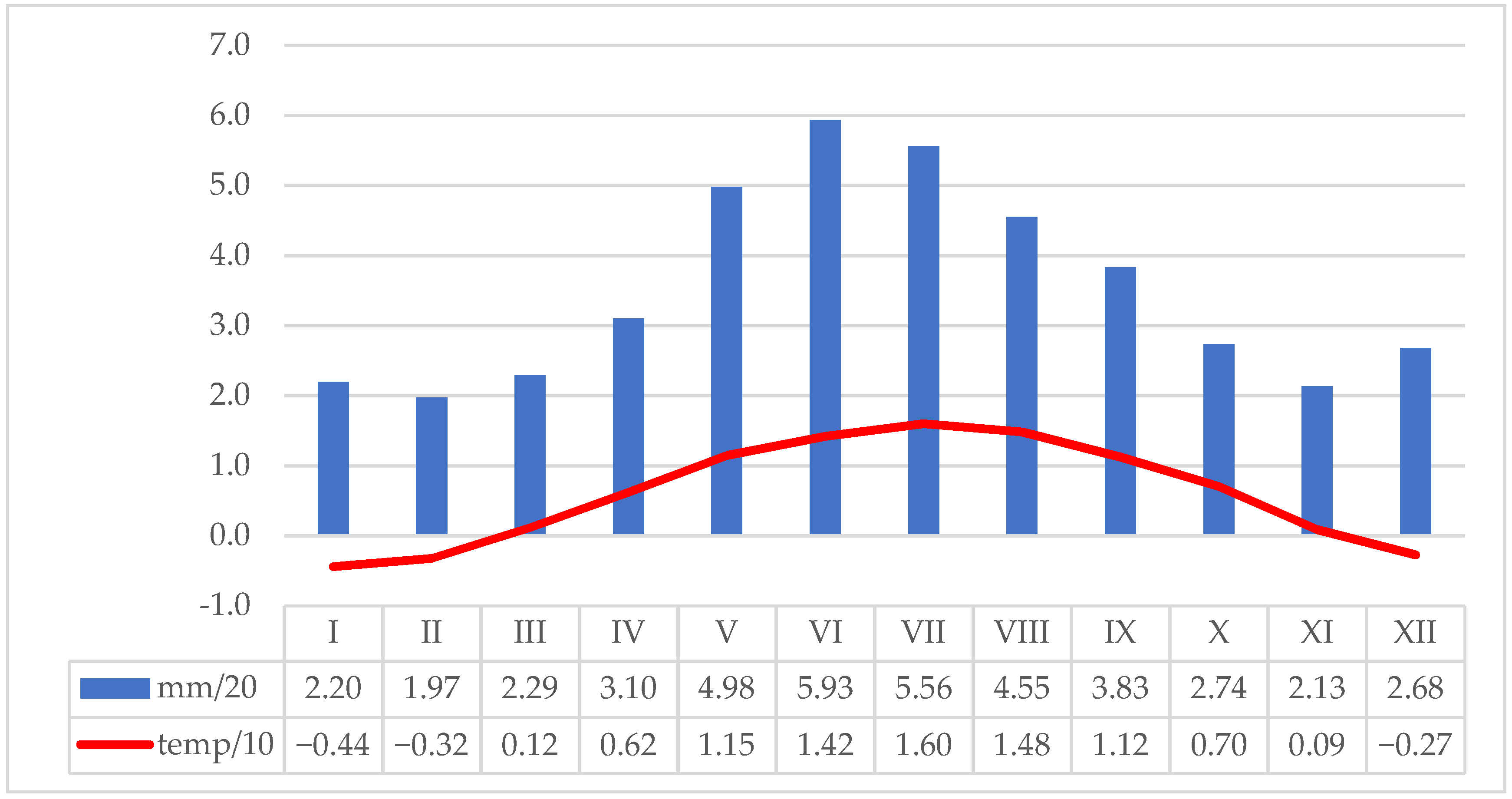
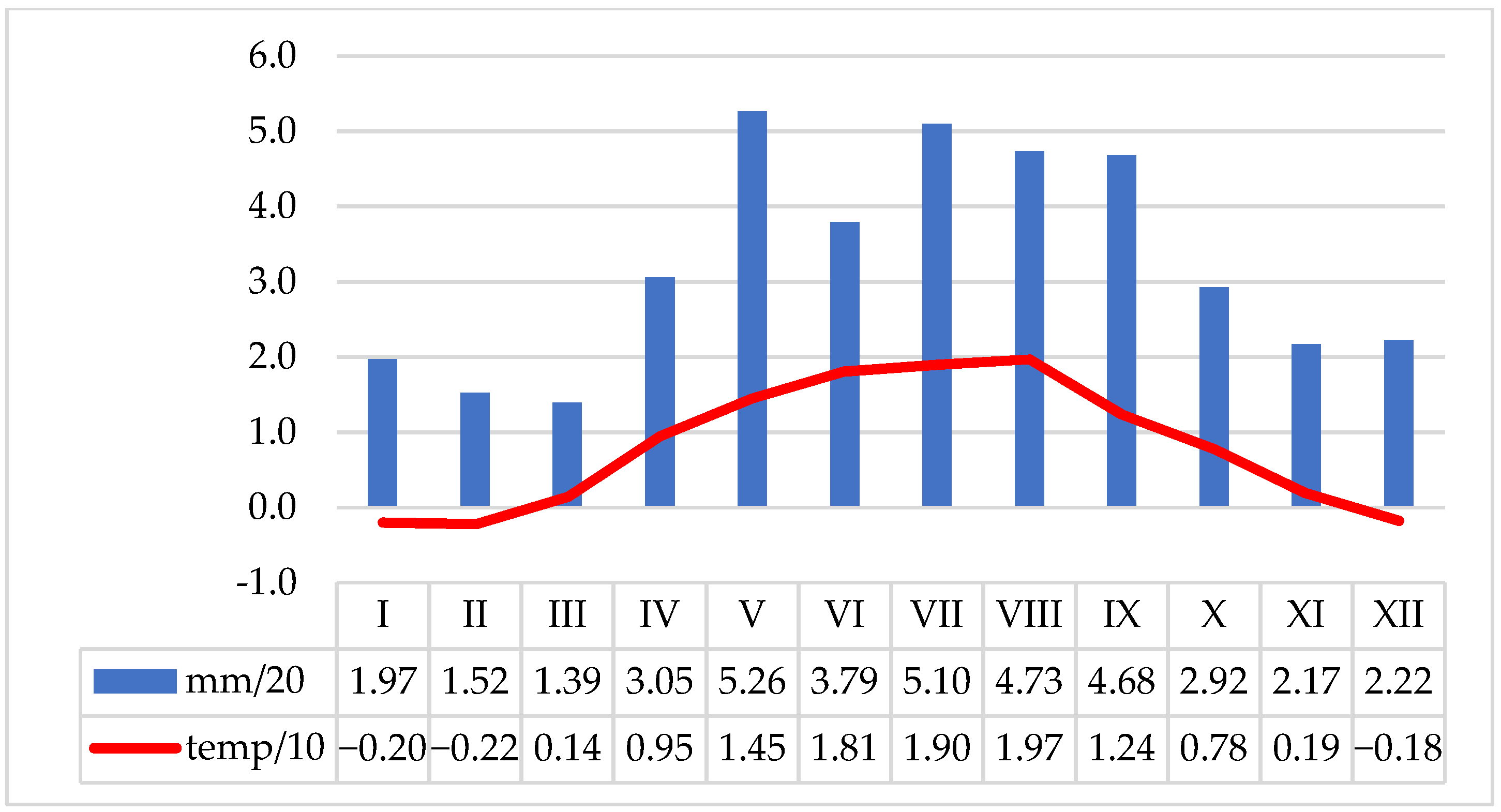
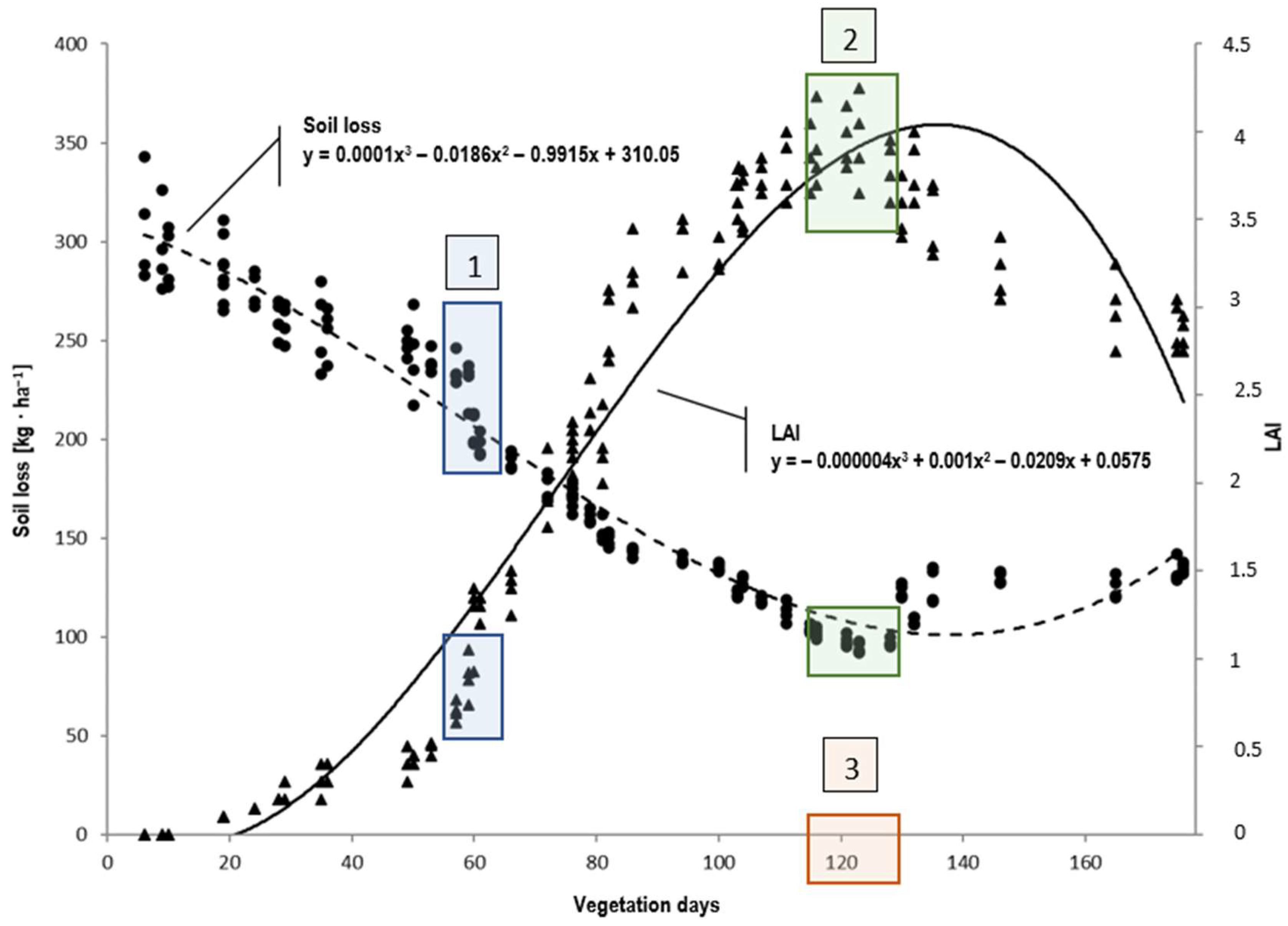
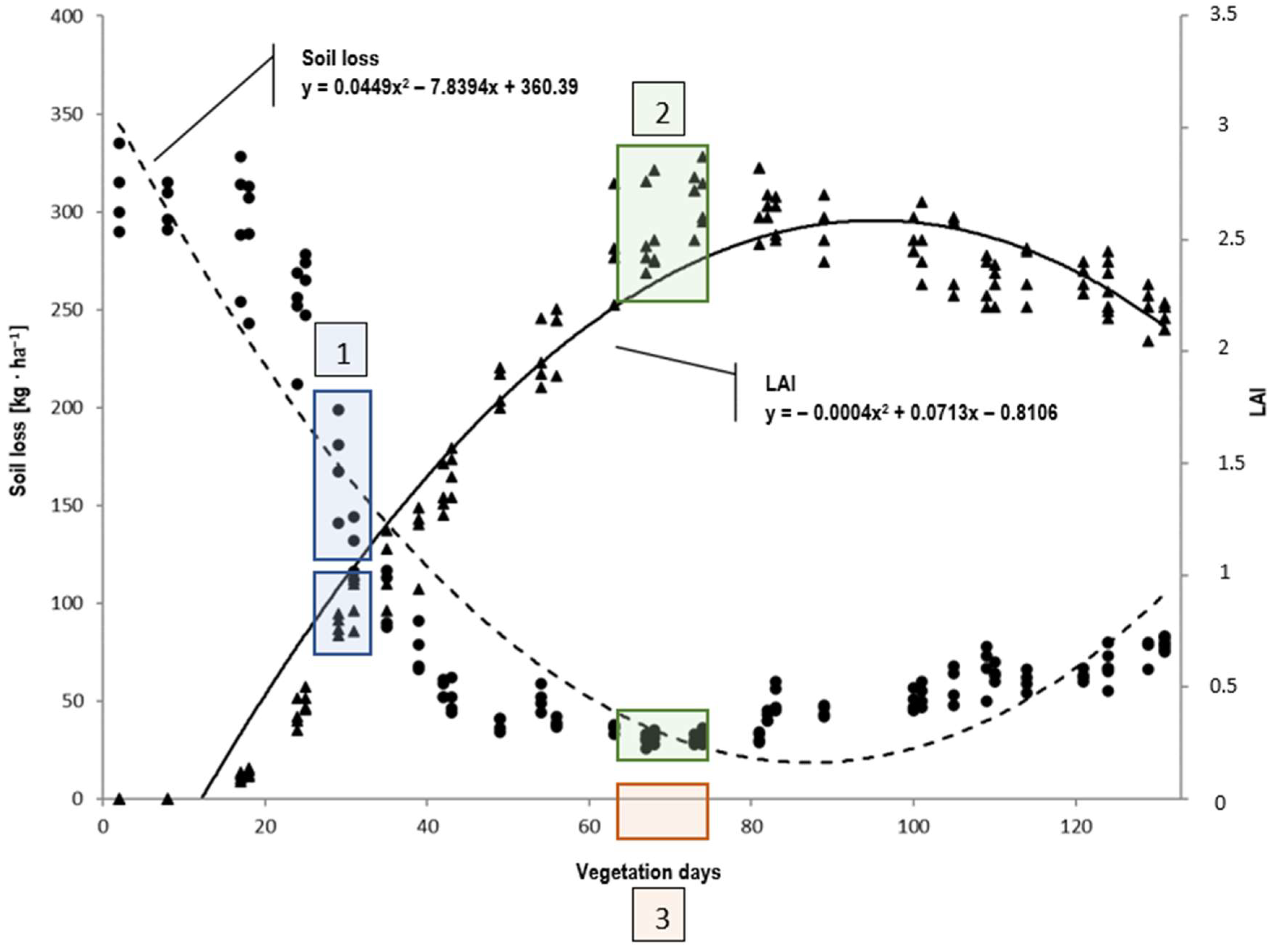
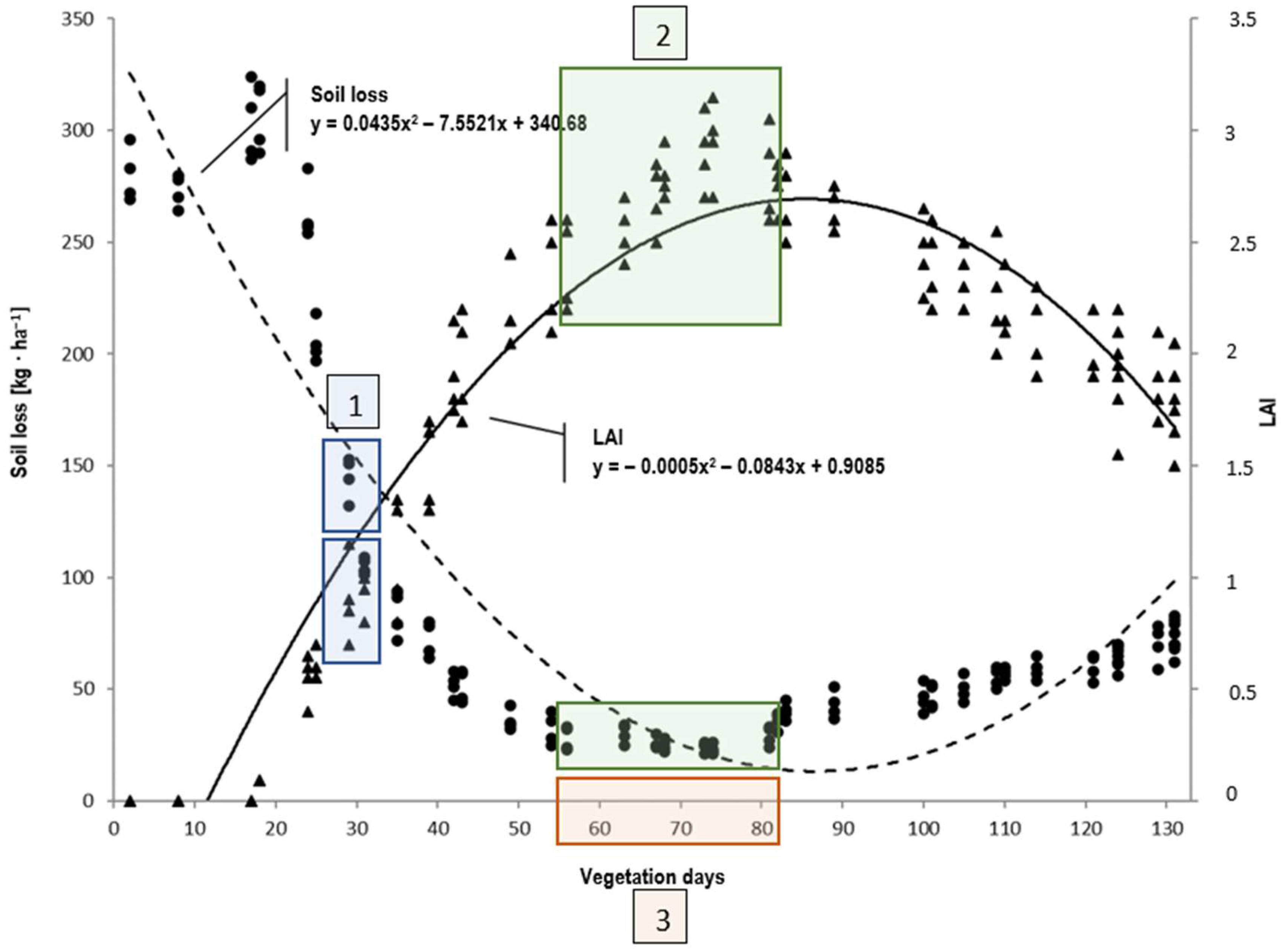
| Snow-Melt Seasons and Dates of Rainfall | Water Storage in Snow (mm) | Duration of Rainfall (min) | Rainfall Total (mm) | Maximum Intensity (mm·min−1) | Classification of Rainfall According to [32] * |
|---|---|---|---|---|---|
| 2017 | |||||
| 14–25 February | 27.6 | ||||
| 17–18 April | 136 | 27.4 | 0.04 | 1 | |
| 28 April | 75 | 29.6 | 0.6 | 3 | |
| 30 May | 35 | 26.6 | 1.0 | 3 | |
| 4 June | 31 | 20.2 | 0.9 | 3 | |
| 23 June | 34 | 26.3 | 0.9 | 3 | |
| 20 August | 42 | 46.8 | 1.6 | 4 | |
| 12 September | 42 | 24.8 | 0.7 | 3 | |
| 17 September | 54 | 32.2 | 0.6 | 3 | |
| 22 October | 39 | 23.4 | 0.8 | 3 | |
| 2018 | |||||
| 1–11 January | 32.0 | ||||
| 8 May | 35 | 24.8 | 0.8 | 3 | |
| 17–18 May | 1790 | 38.8 | 0.02 | 1 | |
| 17 July | 39 | 41.2 | 1.4 | 4 | |
| 11 August | 34 | 29.7 | 1.1 | 3 | |
| 25 August | 31 | 32.2 | 1.9 | 4 | |
| 4 September | 52 | 34.6 | 0.7 | 3 | |
| 2019 | |||||
| 12–18 January | 31.9 | ||||
| 28 April | 56 | 43.2 | 0.9 | 3 | |
| 14–15 May | 1060 | 34.0 | 0.07 | 1 | |
| 22 May | 32 | 35.4 | 1.6 | 4 | |
| 23 May | 57 | 49.7 | 1.1 | 3 | |
| 24 July | 25 | 23.4 | 1.3 | 3 | |
| 11–12 August | 720 | 33.3 | 0.07 | 1 | |
| 23 August | 39 | 23.2 | 0.9 | 3 | |
| 2020 | |||||
| 2 May | 0.00 | 26 | 22.3 | 1.2 | 3 |
| 16–20 June | 1250 | 40.6 | 0.08 | 1 | |
| 27 June | 34 | 25.3 | 1.2 | 3 | |
| 15–17 July | 1320 | 41.9 | 0.07 | 1 | |
| 16 August | 32 | 32.2 | 1.6 | 4 | |
| 1 September | 43 | 38.0 | 1.1 | 3 | |
| 1–2 October | 720 | 23.6 | 0.06 | 1 | |
| 12 October | 27 | 22.4 | 1.0 | 3 | |
| 13 October | 53 | 37.6 | 0.8 | 3 | |
| 2021 | |||||
| 13 April | 0.00 | 53 | 24.4 | 0.7 | 3 |
| 13 May | 29 | 22.5 | 1.1 | 3 | |
| 18 May | 30 | 24.1 | 1.2 | 3 | |
| 23 June | 46 | 35.4 | 0.9 | 3 | |
| 24 June | 34 | 36.8 | 1.6 | 4 | |
| 9 July | 34 | 27.2 | 1.2 | 3 | |
| 15 July | 60 | 56.1 | 1.3 | 5 | |
| 5 August | 63 | 56.3 | 1.0 | 5 | |
| 9 August | 28 | 23.4 | 1.1 | 3 | |
| 17 September | 31 | 23.2 | 0.9 | 3 | |
| 2022 | |||||
| 15–16 April | 0.00 | 690 | 21.0 | 0.08 | 1 |
| 9 June | 26 | 20.2 | 1.0 | 3 | |
| 16 June | 30 | 21.2 | 0.9 | 3 | |
| 5 July | 39 | 33.0 | 1.3 | 3 | |
| 23 July | 35 | 28.4 | 1.1 | 3 | |
| 13 August | 28 | 23.0 | 1.2 | 3 | |
| 21 August | 27 | 28.6 | 1.7 | 4 | |
| * | Rainfall total | Maximum intensity | |||
| (mm) | (mm·min−1) | ||||
| 1—Short-term rainfall of low intensity | up 90 | 0.01–0.07 | |||
| 2—Long-term rainfall of low intensity | 91–300 | 0.08–0.19 | |||
| 3—Short rain | up 30 | 0.20–1.30 | |||
| 4—Short-term downpour | 31–50 | 1.40–2.20 | |||
| 5—Torrential rain | 51–90 | 0.80–1.30 | |||
| 6—Extensive rain periodically changing to downpour | 91–300 | extensive rain: 0.01–0.16 downpour: 1.40–2.20 | |||
| Plant Species | 2017 | 2018 | 2019 | 2020 | 2021 | 2022 |
|---|---|---|---|---|---|---|
| Hulled oats | S * 11 April | 9 April | 10 April | 7 April | 17 April | 14 April |
| H * 22 August | 14 August | 15 August | 18 August | 11 August | 22 August | |
| Spring vetch | S * 11 April | 9 April | 10 April | 7 April | 17 April | 14 April |
| H * 21 August | 13 August | 14 August | 15 August | 11 August | 22 August | |
| Fodder maize | S * 21 April | 20 April | 19 April | 22 April | 24 April | 20 April |
| H * 13 October | 15 October | 13 October | 15 October | 14 October | 15 October |
| Evaluated Period | Maize | Oats | Vetch | Average | |
|---|---|---|---|---|---|
| (a) from sowing to harvest | 1302.10 | 589.60 | 538.30 | 810.00 | |
| LSD * α = 0.05 | 113.35 | ||||
| (b) annual periods, i.e., from 1 January to 31 December | 1441.60 | 1012.50 | 961.20 | 1138.43 | |
| LSD α = 0.05 | 141.91 | ||||
Disclaimer/Publisher’s Note: The statements, opinions and data contained in all publications are solely those of the individual author(s) and contributor(s) and not of MDPI and/or the editor(s). MDPI and/or the editor(s) disclaim responsibility for any injury to people or property resulting from any ideas, methods, instructions or products referred to in the content. |
© 2024 by the authors. Licensee MDPI, Basel, Switzerland. This article is an open access article distributed under the terms and conditions of the Creative Commons Attribution (CC BY) license (https://creativecommons.org/licenses/by/4.0/).
Share and Cite
Puła, J.; Klima, K.; Kliszcz, A.; Lepiarczyk, A. Anti-Erosion Effectiveness of Selected Crops in Sustainable Mountain Agriculture in a Warming Climate. Sustainability 2024, 16, 8212. https://doi.org/10.3390/su16188212
Puła J, Klima K, Kliszcz A, Lepiarczyk A. Anti-Erosion Effectiveness of Selected Crops in Sustainable Mountain Agriculture in a Warming Climate. Sustainability. 2024; 16(18):8212. https://doi.org/10.3390/su16188212
Chicago/Turabian StylePuła, Joanna, Kazimierz Klima, Angelika Kliszcz, and Andrzej Lepiarczyk. 2024. "Anti-Erosion Effectiveness of Selected Crops in Sustainable Mountain Agriculture in a Warming Climate" Sustainability 16, no. 18: 8212. https://doi.org/10.3390/su16188212
APA StylePuła, J., Klima, K., Kliszcz, A., & Lepiarczyk, A. (2024). Anti-Erosion Effectiveness of Selected Crops in Sustainable Mountain Agriculture in a Warming Climate. Sustainability, 16(18), 8212. https://doi.org/10.3390/su16188212






